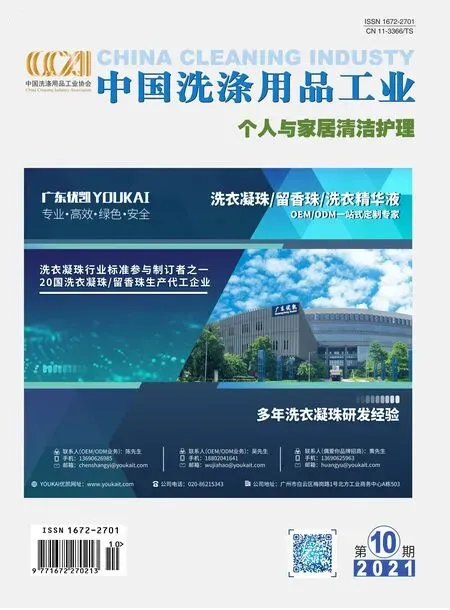表面活性剂和洗涤用品ISO国际标准体系浅析
薛 伟 李晓婷 王开湘 姚晨之
(1. 中轻日用化学检验认证有限公司,山西 太原,030001;2. 全国表面活性剂和洗涤用品标准化技术委员,山西 太原,030001)
当今世界,和平、发展、合作是时代主题。随着“一带一路”倡议的执行,中国与世界各国之间的经济合作愈加频繁,持续推动相关国家和地区经济的快速发展。进行合作的过程中,各国之间存在着各式各样的差异,需要统一的方式对其规范,使合作各方之间能够在同一框架内进行有效的交流互动,避免出现不必要的问题。国际标准,就是经过不同国家和地区的专家们一致通过的这样一类文件,在国际上具有很高的认可程度。国际标准可有效推动多边贸易的进行,是规避合作交流中矛盾产生的一种十分重要的手段。
截至2019年,作为生产生活必需品之一的表面活性剂和洗涤用品全球市场规模已经约9400亿元。在中国境内,2019年洗涤用品市场规模已经达到1100亿元,过去5年的年均复合增长率为5.3%,为同时期全球范围内增速最快的。据弗若斯特沙利文预测,随着社会的发展进步,中国地区的市场规模将会进一步扩大,在2024年可能达到1677亿元;增速也将持续走高,2020—2024年均复合增长率将高达8.7%,远超其他国家和地区的预测值。
在经济全球化的背景下,本文将简单介绍、分析表面活性剂和洗涤用品相关国际标准,以期加速行业与国际接轨,促进我国企业与外国同行之间的合作,助力我国经济高质量快速发展。
1 ISO及ISO/TC 91简介
1.1 ISO简介
国际标准化组织(International Organization for Standardization,ISO)是一个独立的、非官方国际组织,总部位于瑞士日内瓦,目前含有165个国家级标准化组织作为主体成员,23830项国际标准,794个技术委员会和分技术委员会(截至2021年5月)。其宗旨为促进标准化及相关活动的发展,以便于国际物资交流和服务,并扩大在知识、科学、技术、经济等领域的合作。其前身为成立于1926年的国际标准化协会,在第二次世界大战期间各项工作中断。在1946年,来自中国、美国、法国、英国等25个国家的64名代表在伦敦共同决定成立ISO,讨论形成组织章程和议事规则(于1993年修订),并于1947年正式宣告成立。中国是初始理事国之一,由于种种原因1950年被停止会籍,1978年恢复成员身份。目前,中国为ISO六个常任理事国之一。尽管ISO不属于联合国,但其与联合国下属多个机构合作密切,尤其是国际电工委员会(简称IEC)。IEC主要负责电子电工领域相关国际标准化,其余领域均由ISO负责。
ISO标准的制定是一个严格、复杂的过程,需要经过多个阶段才能完成,其具体流程见图1。
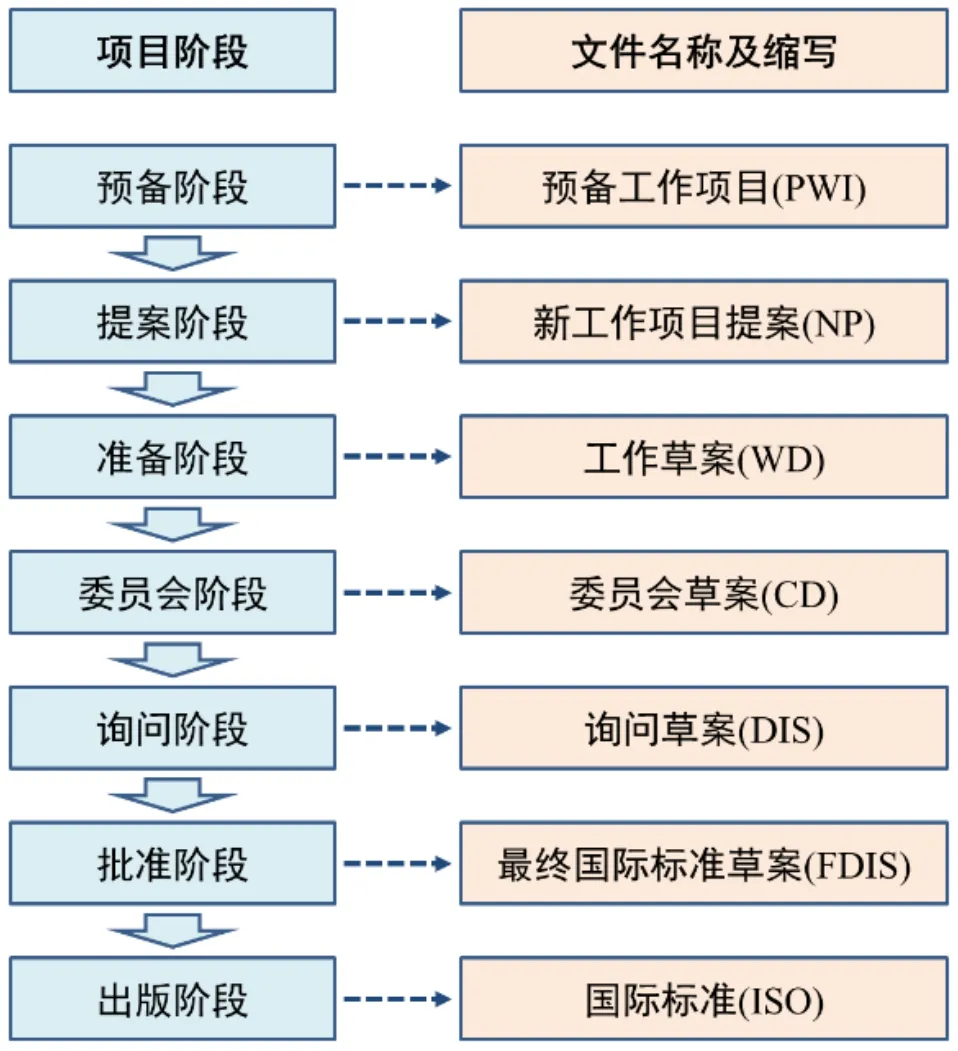
图1 ISO标准形成流程
预备阶段,提出尚不成熟的新工作项目计划,研究以形成预备工作项目。提案阶段,需要至少5个P成员国(可参与ISO各项活动,拥有投票权,能够提名项目组专家)承诺积极参加,派技术专家参与,且技术委员会P成员国简单多数批准,形成新工作项目提案。在准备阶段,各参与成员国应在6个月内提供所形成的工作草案,并提交至技术委员会。委员会阶段,技术处向各成员国征求意见(3个月),整理后形成委员会草案。询问阶段,进行为期5个月的联合投票,需要满足“协商一致”原则方可形成询问草案,即当2/3的P成员国赞同,同时应尽量解决反对票中所提出问题。如果委员会草案讨论未达成一致意见,则需要进一步修改,直至形成询问草案或放弃提案。从立项到形成询问草案的时间不得超过24个月。批准阶段,进行为期2个月的联合投票,当2/3的P成员国赞同且反对票不超过1/4时(不计弃权票),询问草案通过进入批准阶段,批准国际标准草案成为国际标准或技术规范。出版阶段,在两个月内刊出并分发经校正后的国际标准。在这些阶段中,可根据工作具体情况省去某些环节,如询问草案形成过程中顺利通过且没有反对票,则可跳过批准阶段直接出版。
1.2 ISO/TC 91简介
ISO/TC 91为ISO分技术委员会之一,成立于1958年,其领域主要为表面活性剂,包括含有一种或多种表面活性剂的表面活性剂及其混合物,其中可以含或不含皂类产品和洗涤剂配方中其他传统组分。截至目前,ISO/TC 91成员共计52个,分别含有P成员国14个和O成员国(可参与ISO会议并发表评论,没有投票权,且不能提名项目组专家)38个。与2016年相比,P成员国数量未发生变化,但是O成员国数量增加5个[1],发展速度较快。我国在1980年首次由轻工业部日用化学工业研究所作为对口负责单位,以O成员国的身份参与ISO/TC 91的活动,并在1981年升级为P成员国之一。在2004年,由于机构名称的变更,国内对口负责单位调整为中国日用化学工业研究院(现更名为:中国日用化学研究院有限公司),日常事务则由全国表面活性剂和洗涤用品标准化技术委员(TC 272)代为管理。ISO/TC 91各成员国名单见表1。
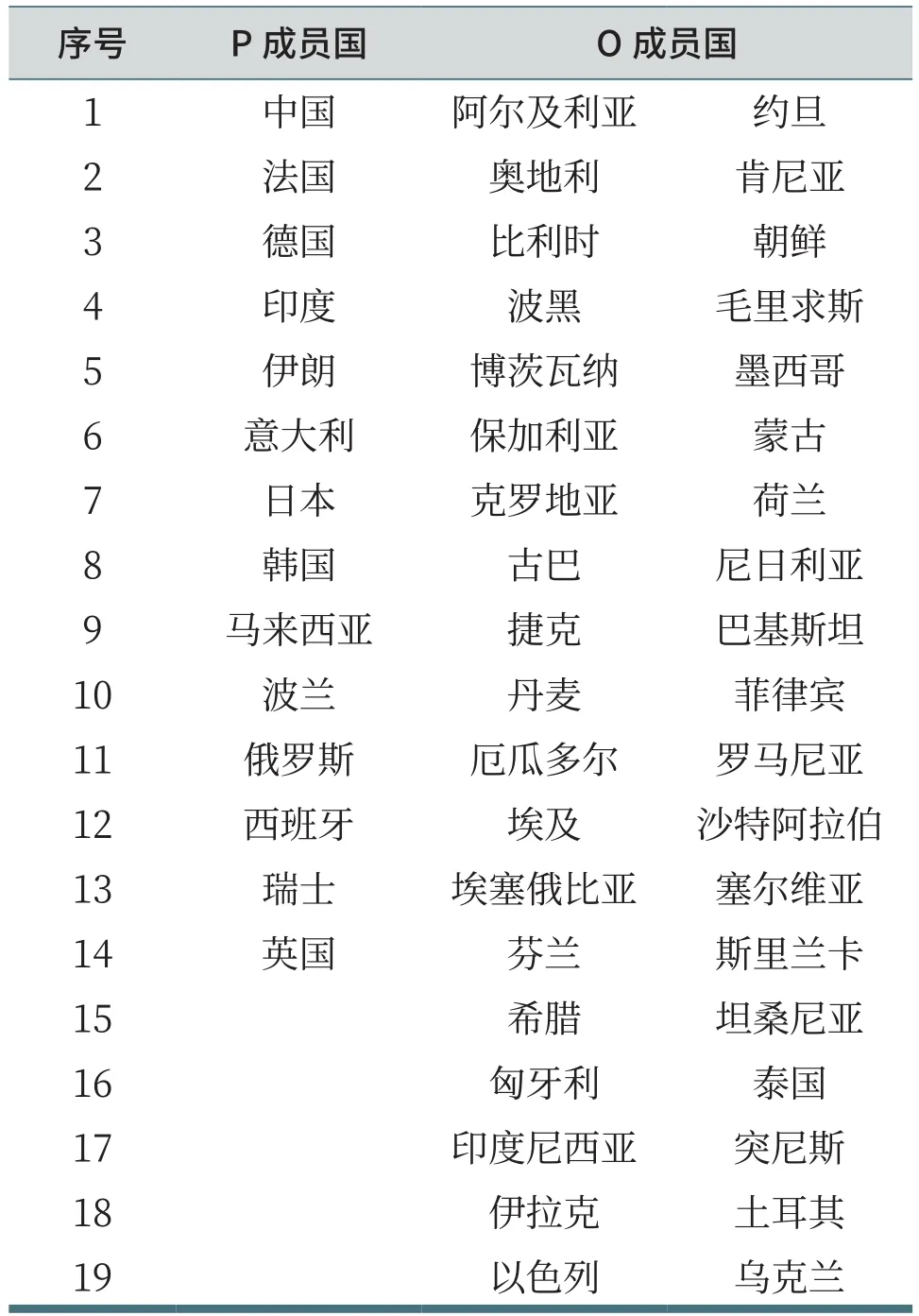
表1 ISO/TC 91中P成员国和O成员国名录
可以看出,ISO/TC 91的成员国已经覆盖了亚洲、欧洲、非洲、北美洲、南美洲五大洲,在世界地图板块中覆盖面较广。其中,P成员国分布于亚洲和欧洲,相对较为集中。O成员国的分布以亚洲、欧洲和非洲为主,南美洲和北美洲相对较少。各个成员国的分布与当地政府的重视程度、经济运行情况、当地该产业发展好坏状况等息息相关。例如,位于东南亚的马来西亚、印度尼西亚、菲律宾等国家油脂化工行业发展蓬勃,该地区在ISO/TC 91的参与度相对较高。
目前,ISO/TC 91共设有四个工作组,分别为:AHG 1、工作组1、工作组3和工作组5,具体名称见表2。
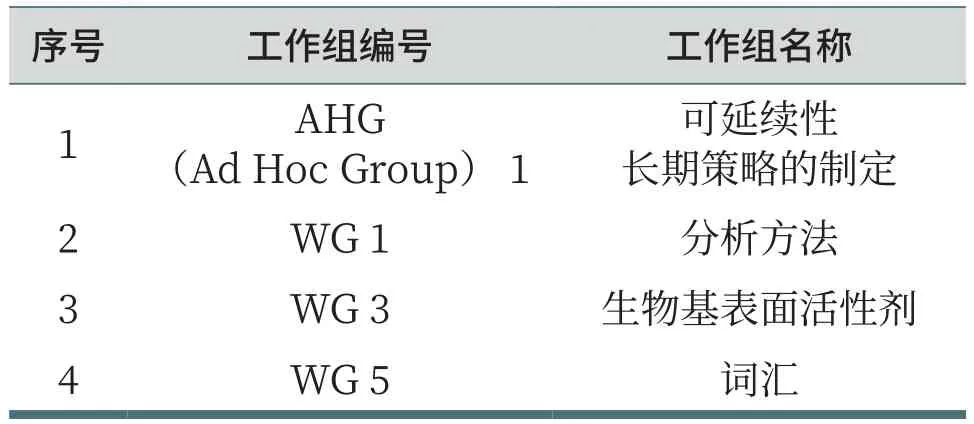
表2 ISO/TC 91工作组概况
工作组的设立可以是根据任务完成情况动态变化的,也可以是永久性的。例如,根据工作需求曾设立工作组“WG 2 微生物工作组”,当该工作结束后工作组随之解散。
2 ISO/TC 91标准体系及分析
2.1 ISO/TC 91标准体系
截至目前,ISO/TC 91累计发布标准82项,尚有2个工作项目正在进行中。已发布的各项标准详细信息见表3。

23 ISO 2267—1986Surface active agents — Evaluation of certain effects of laundering — Methods of preparation and use of unsoiled cotton control cloth 24 ISO 2268—1972Surface active agents (non-ionic) — Determination of polyethylene glycols and non-ionic active matter (adducts) — Weibull method 25 ISO 2270—1989Non-ionic surface active agents — Polyethoxylated derivatives — Iodometric determination of oxyethylene groups 26 ISO 2271—1989Surface active agents — Detergents — Determination of anionic-active matter by manual or mechanical direct two-phase titration procedure 27 ISO 2272—1989Surface active agents — Soaps — Determination of low contents of free glycerol by molecular absorption spectrometry 28 ISO 2456—1986Surface active agents — Water used as a solvent for tests — Specification and test methods 29 ISO 2868—1973Surface active agents — Detergents — Anionic-active matter stable to acid hydrolysis —Determination of trace amounts 30 ISO 2869—1973Surface active agents — Detergents — Anionic-active matter hydrolyzable under alkaline conditions — Determination of hydrolyzable and non-hydrolyzable anionic-active matter 31 ISO 2870—2009Surface active agents — Detergents — Determination of anionic-active matter hydrolysable and non-hydrolysable under acid conditions 32 ISO 2871—1—2010 Surface active agents — Detergents — Determination of cationic-active matter content —Part 1 High-molecular-mass cationic-active matter 33 ISO 2871—2—2010 Surface active agents — Detergents — Determination of cationic-active matter content —Part 2 Cationic-active matter of low molecular mass (between 200 and 500)34 ISO 4198—1984Surface active agents — Detergents for hand dishwashing — Guide for comparative testing of performance 35 ISO 4311—1979Anionic and non-ionic surface active agents — Determination of the critical micellization concentration — Method by measuring surface tension with a plate, stirrup or ring 36 ISO 4312—1989Surface active agents — Evaluation of certain effects of laundering — Methods of analysis and test for unsoiled cotton control cloth 37 ISO 4313—1976Washing powders — Determination of total phosphorus (V) oxide content — Quinoline phosphomolybdate gravimetric method 38 ISO 4314—1977Surface active agents — Determination of free alkalinity or free acidity — Titrimetric method 39 ISO 4315—1977Surface active agents — Determination of alkalinity — Titrimetric method 40 ISO 4316—1977Surface active agents — Determination of pH of aqueous solutions — Potentiometric method 41 ISO 4317—2011Surface-active agents and detergents — Determination of water content — Karl Fischer methods 42 ISO 4318—1989Surface active agents and soaps — Determination of water content — Azeotropic distillation method 43 ISO 4319—1977Surface active agents — Detergents for washing fabrics — Guide for comparative testing of performance 44 ISO 4320—1977Non-ionic surface active agents — Determination of cloud point index — Volumetric method

45 ISO 4321—1977Washing powders — Determination of active oxygen content — Titrimetric method 46 ISO 4322—1977Non-ionic surface active agents — Determination of sulphated ash — Gravimetric method 47 ISO 4323—2018Soaps — Determination of chloride content — Potentiometric method 48 ISO 4324—1977Surface active agents — Powders and granules — Measurement of the angle of repose 49 ISO 4325—1990Soaps and detergents — Determination of chelating agent content — Titrimetric method 50 ISO 4326—1980Non-ionic surface active agents — Polyethoxylated derivatives — Determination of hydroxyl value — Acetic anhydride method 51 ISO 4327—1979Non-ionic surface active agents — Polyalkoxylated derivatives — Determination of hydroxyl value — Phthalic anhydride method 52 ISO 6121—1988Surface active agents — Technical alkane sulfonates — Determination of alkane monosulfonates content by direct two-phase titration 53 ISO 6122—1978Surface active agents — Technical alkane sulphonates — Determination of total alkane sulphonates content 54 ISO 6384—1981Surface active agents — Technical ethoxylated fatty amines — Methods of analysis 55 ISO 6387—1983Surface active agents — Determination of the power to disperse calcium soap —Acidimetric method (Modified Schonfeldt method)56 ISO 6388—1989Surface active agents — Determination of flow properties using a rotational viscometer 57 ISO 6835—1981Surface active agents — Washing powders — Determination of total boron content —Titrimetric method 58 ISO 6836—1983Surface active agents — Mercerizing agents — Evaluation of the activity of wetting products for mercerization by determination of the shrinkage rate of cotton 59 ISO 6837—1982Surface active agents — Water dispersing power in dry cleaning solvents 60 ISO 6839—1982Anionic surface active agents — Determination of solubility in water 61 ISO 6840—1982Cationic surface active agents (Hydrochlorides and hydrobromides) — Determination of critical micellization concentration — Method by measurement of counter ion activity 62 ISO 6841—1988Surface active agents — Technical straight-chain sodium alkylbenzenesulfonates —Determination of mean relative molecular mass by gas-liquid chromatography 63 ISO 6842—1989Surface active agents — Sulfated ethoxylated alcohols and alkylphenols — Determination of total active matter content 64 ISO 6843—1988Surface active agents — Sulfated ethoxylated alcohols and alkylphenols — Estimation of the mean relative molecular mass 65 ISO 6844—1983Surface active agents — Determination of mineral sulfate content — Titrimetric method 66 ISO 6845—1989Surface active agents — Technical alkane sulfonates — Determination of the mean relative molecular mass of the alkane monosulfonates and the alkane monosulfonate content 67 ISO 6889—1986Surface active agents — Determination of interfacial tension by drawing up liquid films 68 ISO 7535—1984Surface active agents — Detergents for domestic machine dishwashing — Guide for comparative testing of performance 69 ISO 8022—1990Surface active agents — Determination of wetting power by immersion
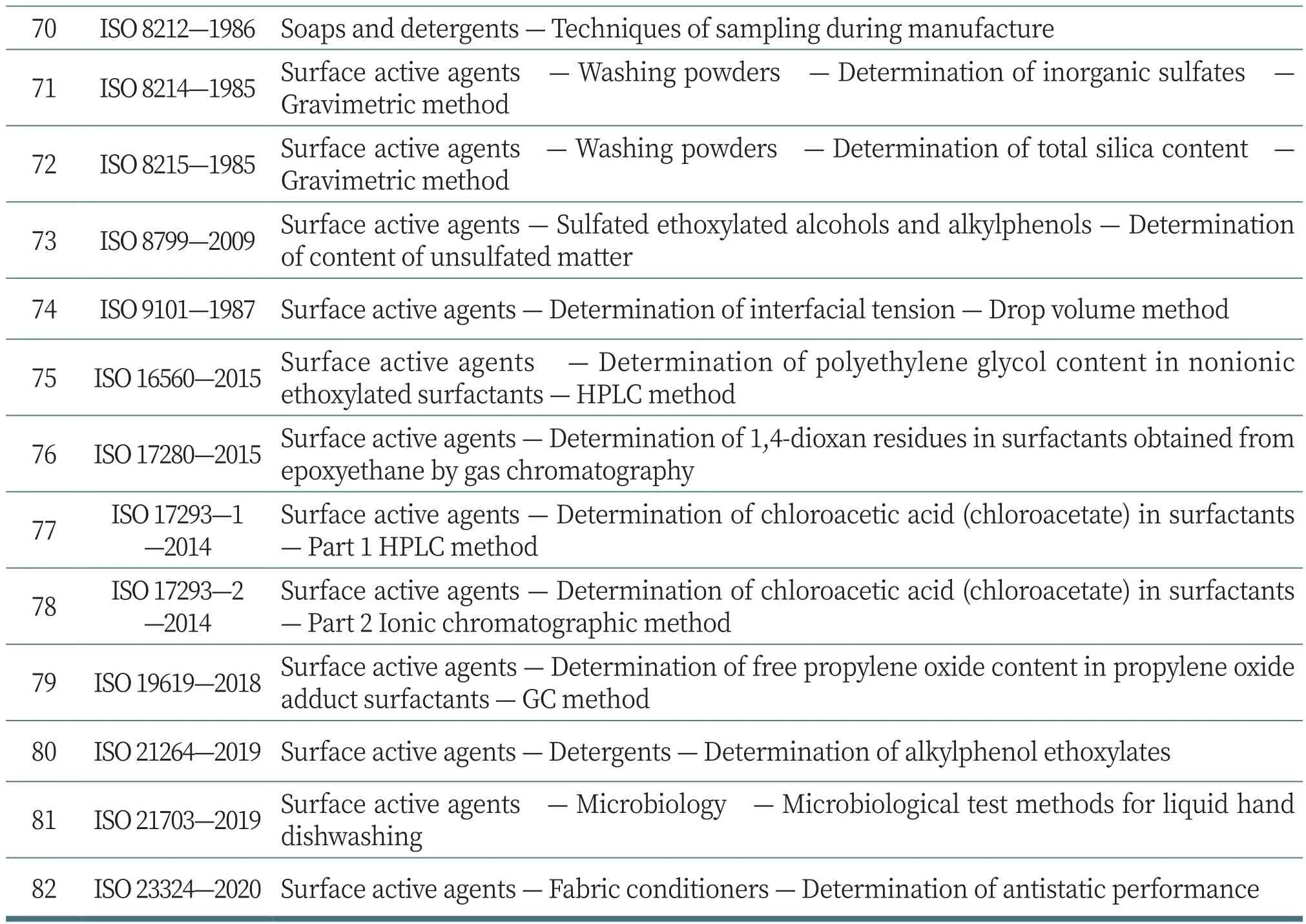
70 ISO 8212—1986 Soaps and detergents — Techniques of sampling during manufacture 71 ISO 8214—1985 Surface active agents — Washing powders — Determination of inorganic sulfates —Gravimetric method 72 ISO 8215—1985 Surface active agents — Washing powders — Determination of total silica content —Gravimetric method 73 ISO 8799—2009 Surface active agents — Sulfated ethoxylated alcohols and alkylphenols — Determination of content of unsulfated matter 74 ISO 9101—1987 Surface active agents — Determination of interfacial tension — Drop volume method 75 ISO 16560—2015Surface active agents — Determination of polyethylene glycol content in nonionic ethoxylated surfactants — HPLC method 76 ISO 17280—2015Surface active agents — Determination of 1,4-dioxan residues in surfactants obtained from epoxyethane by gas chromatography 77 ISO 17293—1—2014 Surface active agents — Determination of chloroacetic acid (chloroacetate) in surfactants— Part 1 HPLC method 78 ISO 17293—2—2014 Surface active agents — Determination of chloroacetic acid (chloroacetate) in surfactants— Part 2 Ionic chromatographic method 79 ISO 19619—2018Surface active agents — Determination of free propylene oxide content in propylene oxide adduct surfactants — GC method 80 ISO 21264—2019Surface active agents — Detergents — Determination of alkylphenol ethoxylates 81 ISO 21703—2019Surface active agents — Microbiology — Microbiological test methods for liquid hand dishwashing 82 ISO 23324—2020Surface active agents — Fabric conditioners — Determination of antistatic performance
表3列出现行有效的82项标准。除此之外,还有两项工作正在进行,分别是:ISO/CD TR 21681 Surface active agents — Bio-based surfactants — Overview on surfactants containing biomass和ISO/AWI 24287.2 Liquid laundry detergent capsules (packets) —Safety guidelines, test methods, labelling,packaging。
2.2 随年份发布情况
ISO/TC 91自1958年成立以来,早期制定新的标准数量较少,曾有多份标准草案提交至秘书处,遗憾的是均未能顺利获得投票通过,最终撤回或被取消。目前,现有标准体系中发布时间最早的标准是1972年。该技术委员会旗下标准历年发布情况见图2。
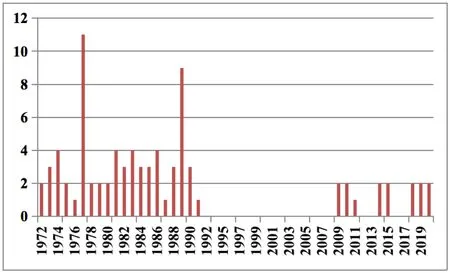
图2 ISO/TC 91历年发布标准情况
从图2可以看出,标准的发布情况呈现出鲜明的特点,主要可以分为三个阶段:1972—1991年、1992—2009年和2010年至今。在第一阶段,每年均有新标准对外发布,最多的1977年发布多达11项,1989年同样有9项标准获批,期间累计发布标准67项,平均每年发布标准3.3项,为ISO/TC 91发布标准的高产期。而到了第二阶段,整个技术委员会陷入沉寂,在长达18年的时间段内未发布任何一份标准,标委会活动处于中断状态。在此期间,技术委员会秘书处也由最初的法国调整为伊朗。与第一阶段标准连年持续发布不同,2010年起的第三阶段,又开始有标准陆续发布,但每年的发布量均未超过2件。在这个阶段中,中国是其中最活跃的成员国,中国参与制修订的标准将在后续篇幅中进行讨论。
另外一个较为显著的特点是:在第一阶段中制定的方法标准主要以化学分析为主,分析精度相对较低;而在第三阶段中制修订的标准使用更多精密仪器,测试方法的准确度得到进一步提升。这一现象主要是与当今时代仪器分析的飞速发展有关,同样还可能与消费者在安全、健康等方面需求的变化密不可分。
2.3 分类
按照标准的类型,对现有的82项标准进行分类,结果见图3。
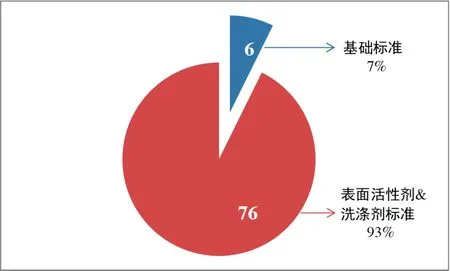
图3 ISO/TC 91标准分类
从图3中可以看出,现有标准主要是以表面活性剂和洗涤剂为主,多达76项,且均为方法标准,约占总数量的93%。而基础标准(适用于所有表面活性剂及洗涤剂)仅有6项,只占7%。如果再按照产品类别的不同进行细分,如表面活性剂类型,上述76项标准又可以分为如图4所示的情况。
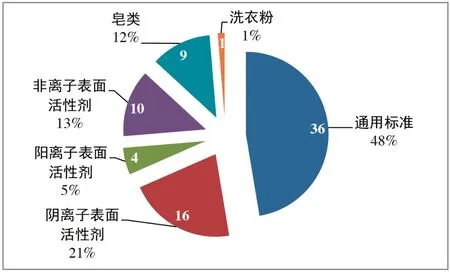
图4 ISO/TC 91标准中表面活性剂及洗涤剂标准细分情况
从图4中可以发现,通用标准(对于某一类产品通用的标准)多达36项,几乎占据半壁江山;在各类表面活性剂相关标准中,由多到少的次序依次是阴离子型(16项,占比21%)>非离子型(10项,占比13%)>阳离子型(4项,占比5%),该顺序与目前洗涤用品中所添加的表面活性剂原料的用量顺序一致。两性表面活性剂则没有专门的标准对其进行规范,可能是因为其用量相对较小、覆盖范围相对较窄所导致。随着洗涤剂配方的更新换代,其中所使用表面活性剂类别同样在发生变化。在不久的将来,尽管阴离子型表面活性剂的用量依然巨大,但相关标准总数量及比例可能会被应用范围日渐拓展的非离子型表面活性剂超越。除了表面活性剂外,皂类产品相关的检测方法标准有9项,占到了12%;与之相比,洗衣粉相关标准仅有1项,远远少于皂类产品;另一类常用的家用洗涤剂—液体洗涤剂,则没有任何相关的检测方法标准,这与实际应用场景存在着显著的不匹配现象。
2.4 中国主导制定情况
2009年,在日本东京举办的第16届标委会会议中,中国代表团向秘书处提出申请希望能够积极参加到国际标准的制修订工作。自那时起,中国身影频繁出现在标委会的各项活动中,现已刊出的、由中国主导制修订的标准共9项,占同期ISO/TC 91形成标准总数量的60%。表4列出上述9项标准的相关信息。

表4 中国主导制修订的ISO/TC 91标准
其中,ISO 685—2020和ISO 4323—2018为修订已有标准,其余7项则为新制定。此外,这些标准中,所使用的方法大多使用大型仪器,用化学方法进行测定的比例甚低,这在一定程度上折射出如今该领域的发展动态。随着中国方面的持续参与,将有越来越多的中国主导标准的问世。
3 展望
从整体上讲,ISO/TC 91标准体系已经较为完善,检测方法等基本覆盖表面活性剂常见各类指标。在以后的发展过程中,可在下述一些方面进行完善。
(1)持续发展壮大成员国队伍,使更多的国家和地区参与进来,听到更多不同的声音,这样才能更好地发现问题并解决问题,推动行业持续健康向好发展。
(2)重点研究表面活性剂领域(可能)存在的社会热点问题,如环境相关问题,在检测方法的绿色化等方面加大人力物力的投入,为全球可持续发展做出应有贡献。
(3)覆盖范围拓展,针对现有体系中未涉及的较为小众的表面活性剂产品等建立相应的分析测试方法,在方便监控产品质量的同时逆向推进制备工艺的改善。
(4)方法的更新换代,体系中大多数检测方法标准使用的是化学法,可随着时代的发展进步及消费者要求的提升,逐步将其更新为准确程度更高的仪器分析法,保持与时俱进,引领行业创新发展。
(5)进一步增强成员国之间的合作交流,分享所在地区本领域,甚至是其他相关领域的资料供参考借鉴,加速交叉领域知识碰撞,以便于更全面地完善现有标准,并在制定新标准的过程中规避可能出现的问题。

